B0 Field Management & Shimming
B0 Field Management & Shimming
Oral
Oral
Engineering
Monday, 13 May 2019
| Room 710B | 13:45 - 15:45 | Moderators: William Handler, Irena Zivkovic |
| 13:45 |
0212. 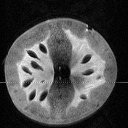 |
Design of a volume MRI coil by metalyzing 3D printing substrates by electroless and/or electroplating processes
Simon Lambert, Tony Gerges, Romain Delamea, Mathilde Bigot, Hugo Dorez, Philippe Lombard, Vicent Semet, Michel Cabrera
Manufacturing compact, miniature devices required for small samples imaging is still challenging. Here we investigate the feasibility of metalyzing 3D printing subtrates to develop a volume coil dedicated to both small in-vitro / ex-vivo samples and in vivo mouse brain imaging. In order to validate the use of metalized 3D printed process to build MRI coil we build one reference Helmholtz coil made with copper tape wrapped around the coil mount and one with the same geometry using this new technology. First demonstration on bench and in imaging that copper metallization technology can be performed to build volume coil.
|
13:57 |
0213.  |
Nonlinearity and thermal effects in gradient chains: a cascade analysis based on current and field sensing
Jennifer Nussbaum, Manuela Rösler, Benjamin Dietrich, Klaas Prüssmann
In MRI, many gradient field imperfections are linear and time-invariant to some extend and can be well modelled by gradient impulse response functions. However, time invariance is violated by thermal effects and linearity e.g. by the gradient amplifier. To isolate sources of model violations we split the gradient chain into a cascade, consisting of eddy current compensation, amplifier and coil. Coil and amplifier responses are disentangled by extending the field measurement by current monitoring. Linearity and time-invariance violations are analyzed by performing heating experiments and varying test pulses. We show that current monitoring enables independent treatment of nonlinear distortion and thermal effects and that gradient response nonlinearities can be resolved directly.
|
| 14:09 |
0214 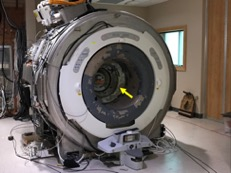 |
Initial imaging experience with a head gradient (MAGNUS) at 3.0T operating at 200 mT/m and 500 T/m/s Video Permission Withheld
Thomas Foo, Ek Tan, Mark Vermilyea, Yihe Hua, Eric Fiveland, Joseph Piel, Keith Park, Justin Ricci, Paul Thompson, Gene Conte, Matthew Tarasek, Desmond Yeo, David Lee, J Kevin DeMarco, Robert Shih, Maureen Hood, Heechin Chae, Vincent Ho
Healthy volunteer subjects were safely imaged in a 3.0 T MRI system with an ultra-high performance head-gradient coil. The MAGNUS coil operates at 200 mT/m and 500 T/m/s, simultaneously on all 3-axes, and has a patient (head) bore diameter of 37-cm. Substantial reduction in pulse sequence TE, TR, and echo-planar imaging echo spacing was achieved with observable improvement in image quality. The design enabled the achievement of higher peripheral nerve stimulation thresholds compared to that for whole-body gradient coils.
|
| 14:21 |
0215. 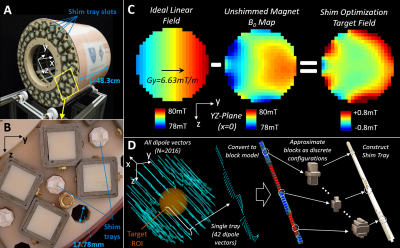 |
A target-field shimming approach for improving the encoding performance of a lightweight Halbach magnet for portable brain MRI
Patrick McDaniel, Clarissa Cooley, Jason Stockmann, Lawrence Wald
Portable brain MRI scanners have the potential to increase the reach of diagnostic imaging but require relaxing constraints such as magnet homogeneity and gradient linearity or even elimination of gradient switching via a rotating magnet with built-in encoding fields. Nonetheless, the encoding matrix must retain good conditioning and excessive signal bandwidth must be controlled. To address this, we developed and validated a permanent magnet shimming method for a lightweight Halbach-style brain imaging magnet and designed and constructed a pair of compact, head-only phase encoding gradients. We demonstrate these improvements in spatial encoding with head-sized phantom and in vivo brain images.
|
14:33 |
0216. 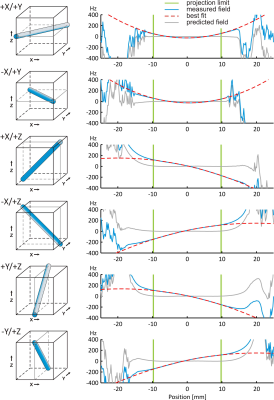 |
FAMASITO - FASTMAP Shim Tool Towards User-Friendly Single-Step B0 Homogenization
Karl Landheer, Christoph Juchem
Fast, automatic shimming by mapping along projections (FASTMAP) is an elegant analytical method developed to quantify 3-dimensional first and second order spherical harmonic B0 shapes along six 1-dimensional column projections. The straightforward application of this theoretical concept to B0 shimming, however, neglects crucial aspects of sequence implementation and shim hardware, commonly necessitating multi-step iterative adjustments. Considering experimental imperfections of the employed B0 mapping and shim coil hardware, we demonstrate optimal single-step adjustment of first and second order terms (with potential <3% refinement of linear terms) in the anterior cingulate cortex, one of the most difficult-to-shim areas in the human brain.
|
14:45 |
0217. 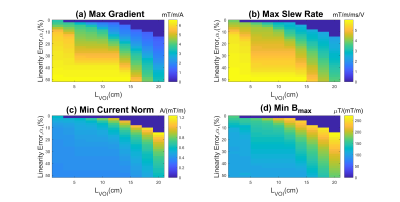 |
Dynamic Optimization of Gradient Field Performance Using a Z-Gradient Array
Koray Ertan, Soheil Taraghinia, Ergin Atalar
Performance parameters of gradient coils such as size of the linearity volume, linearity error, inductance, power dissipation, gradient strength per unit current are determined at the design stage. On the contrary, array of gradient coils driven by independent amplifiers can enable optimization of this parameters. Therefore, optimal gradient performance can be realized depending on the sequence requirements and target volumes. Nine channel z-gradient array is used to optimize various performance parameters and to analyze the tradeoffs between them. Linear gradient profile generated by Z-gradient array hardware is used as readout gradient to demonstrate the feasibility of the hardware.
|
14:57 |
0218. 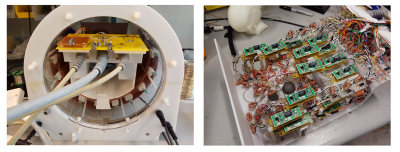 |
A 16-Channel RF Receive Array with Integrated B0-shim Capability for Anesthetized Monkey Whole Brain Imaging at 7T
Yang Gao, Azma Mareyam, Xiaotong Zhang, Yi Sun, Thomas Witzel, Nicolas Arango, Irene Kuang, Jacob White, Anna Roe, Lawrence Wald, Jason Stockmann
To mitigate signal dropout in EPI images due to local B0 inhomogeneities inevitably caused by craniotomies and chamber implantations needed for multimodal studies, we designed a custom 16-channel tight-fit receive array, with each receive element integrated with DC pathway for multi-coil B0 shimming. The feasibility of constructing high-density receive array (5cm diameter loop elements) integrated with B0-Shim has been demonstrated. With DC-enabled higher-order local B0 shimming, obvious improvement in recovering local signal drop out and image distortion around brain surgery region, implying its promising application in high-resolution multi-modal monkey neuroimaging.
|
| 15:09 |
0219 |
Dynamic Multi-Coil Technique (DYNAMITE) MRI on Human Brain Video Permission Withheld
Christoph Juchem, Michael Mullen, Chathura Kumaragamage, Lance DelaBarre, Gregor Adriany, Peter Brown, Scott McIntyre, Terence Nixon, Michael Garwood, Robin de Graaf
To date, spatial encoding for human MRI is based on linear X, Y and Z field gradients generated by dedicated X, Y and Z gradient coils. We recently introduced the Dynamic Multi-Coil Technique (DYNAMITE) for B0 magnetic field modeling and demonstrated DYNAMITE MRI in a miniaturized setup. In this study we report the first realization of multi-slice DYNAMITE MRI of the in vivo human brain in which all gradient fields are purely DYNAMITE-based. The obtained image fidelity is comparable to MRI with conventional gradient coils, paving the way for full-fledged human DYNAMITE MRI systems.
|
| 15:21 |
0220. 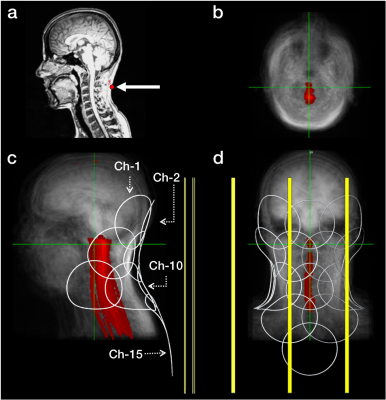 |
Integrated AC/DC coil and dipole Tx array for 7T MRI of the spinal cord
Nibardo Lopez Rios, Ryan Topfer, Alexandru Foias, Axel Guittonneau, Kyle Gilbert, Ravi Menon, Lawrence Wald, Jason Stockmann, Julien Cohen-Adad
Imaging the spinal cord is a never-ending challenge, especially when venturing to ultra-high fields. We propose a novel coil design for spinal cord 7T MRI, which combines state-of-the-art transmit and receive technologies. The transmit coil is a 3-dipole array, allowing homogeneous B1 field with parallel excitation. The receive part consists of a 15-channel AC/DC coil that can achieve both high sensitivity and local B0 shimming, including real-time shimming to compensate for respiratory-induced field variations. The design can achieve 32% reduction of static field inhomogeneities and 27% reduction in temporal field variance, opening the door to exciting EPI and spectroscopy applications.
|
| 15:33 |
0221. 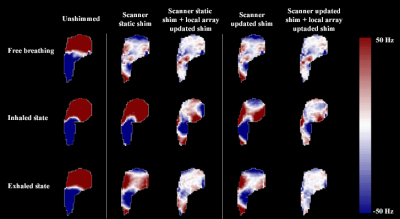 |
B-0 shimming of the liver using a local array of shim coils in the presence of respiratory motion at 7T
Lieke van den Wildenberg, Quincy van Houtum, Wybe van der Kemp, Catalina Arteaga de Castro, Sahar Nassirpour, Paul Chang, Dennis Klomp
Inhomogeneity of the magnetic field (B0) in the human body, for instance caused by physiological motion (e.g. breathing), can lead to artifacts. Static second order magnetic field shimming even in the absence of breathing cannot provide a uniform magnetic field in large organs such as the liver, particularly at ultra-high field throughout the breathing cycle. We show that in conjunction with static second order shimming, local arrays of shim coils can substantially improve the magnetic field uniformity in the liver at different breathing states.
|
 Back to Program-at-a-Glance |
Back to Program-at-a-Glance |  Back to Top
Back to Top